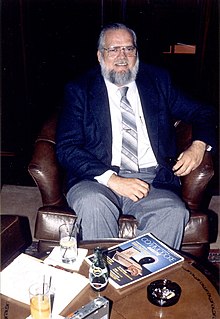Jay Miner
| Jay Glenn Miner | |
|---|---|

Jay Miner in 1990
|
|
| Born |
May 31, 1932 Prescott, Arizona, USA |
| Died | June 20, 1994 (aged 62) Mountain View, California, USA |
| Cause of death | Complications from kidney failure |
| Alma mater | UC Berkeley |
| Occupation | Integrated circuit designer |
| Known for | "Father of the Amiga" |
| Notable work |
Commodore Amiga Atari |
| Spouse(s) | Caroline Miner (1952-1994) |
| Signature | |
 |
|
Jay Glenn Miner (May 31, 1932 – June 20, 1994) was an American integrated circuit designer, known primarily for developing multimedia chips for the Atari 2600 and Atari 8-bit family and as the "father of the Amiga". He received a BS in EECS from UC Berkeley in 1959.
Miner started in the electronics industry with a number of designs in the medical world, including a remote-control pacemaker.
He moved to Atari in the late 1970s. One of his first successes was to combine an entire breadboard of components into a single chip, known as the TIA. The TIA was the display hardware for the Atari 2600, which would go on to sell millions. After working on the TIA he headed up the design of the follow-on chip set known as ANTIC and CTIA for which he holds a patent. These chips would be used for the Atari 8-bit family of home computers and the Atari 5200 video game system.
In the early 1980s, Jay, along with other Atari staffers, had become fed up with management and decamped. They set up another chipset project under a new company in Santa Clara, called Hi-Toro (later renamed to Amiga Corporation), where they could have creative freedom. There, they started to create a new Motorola 68000-based games console, codenamed Lorraine, that could be upgraded to a computer. To raise money for the Lorraine project, Amiga Corp. designed and sold joysticks and game cartridges for popular game consoles such as the Atari 2600 and ColecoVision, as well as an odd input device called the Joyboard, essentially a joystick the player stood on. Atari continued to be interested in the team's efforts throughout this period, and funded them with $500,000 in capital in return for first use of their resulting chipset.
...
Wikipedia
